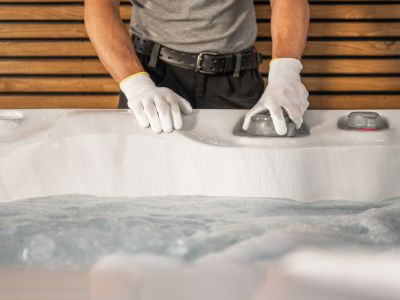A hot water tub promises a mini spa experience at home, but that’s only if you know how to test it right.
In this guide, we’ll discuss how to test hot tub water and ensure it’s safe and chemically balanced.
Why Do You Need To Test Hot Tub Water?
Over time, the tub water can harbour bacteria and accumulate minerals and chemicals. These won’t only affect the tub’s performance and may cause minor damage, but they can also irritate your skin and affect your experience in the tub.
Regular testing of the hot tub water allows you to maintain the right levels of pH, sanitizer—often chlorine or bromine—, and alkalinity. If you manage to keep the water chemically balanced, you’ll avoid common tub issues like cloudy water and skin irritation.
Doing so also helps protect your tub and keep it reserved for the longest time. Unbalanced water can cause mineral buildup, which is costly to repair and may pollute the water.
At-home Test Kits
With the right kit, you can easily test your hot tub water at home. Test strips are the most common method, and spas and gyms often use them. However, liquid test kits provide more accuracy.
They involve more steps, but they give more precise readings, so they may be a nice option for occasional tests.
Aside from test strips and liquid tests, you can always take a sample of the water and send it to a lab for testing. However, that’s the least convenient method because it requires a lot of time. Most of the time, you don’t need the additional accuracy for a home tub except every once in a while.
Here’s everything you need to know about spa test strips and liquid test kits:
Spa Test Strips
Test strips are commonly used by spas because they’re the fastest and most convenient method of testing. All you need to do is buy the strips and dip them in the water for a few seconds.
The strip will then begin to change color, indicating the water’s pH levels, chlorine, and alkalinity.
You’ll receive a guide or a manual with the package that will tell you what each color means.
These strips are perfect for daily tests or fast checks, but they don’t provide high accuracy. You’ll want to use liquid test kits every once in a while to make sure the water is chemically balanced.
Besides, test strips are more affordable, but you’ll run through them fast, so in the end, you’ll be paying nearly the same amount.
Liquid Test Kits
Liquid test kits involve more steps to use, but they’re equally easy and convenient. All you have to do is collect a sample of the hot tub water. Then, use the test’s dropper, filled with a testing liquid, on the sample you collected.
Similarly to test strips, the water will change color, telling you what you need to know about its pH levels and alkalinity. You can hold the water container in front of a white background to see the color clearly.
Using the guide or user manual, you’ll know what each color indicates, but make sure to use the right amounts of testing liquid to get an accurate result.
High pH often results in dark red water, while high chlorine levels may result in slightly dark yellow water. If the water color is too faint to give you an accurate reading, then the levels are probably low. Using a white background always helps.
Asking a Professional

If you haven’t tested your hot tub water for long and want to make sure everything is fine, you can always ask a professional. Instead of having a dealership come into your home, you can collect a sample of the water and deliver it to a lab. They’ll do the necessary testing and give you the results.
You can call ahead and ask if they can send someone to collect a sample.
How Often Should You Test Your Hot Tub Water?
You should test your hot tub water as many times as necessary according to your usage. Some people use the tub once a week or a couple of times a month. In that case, they can test it once every week.
On the other hand, if you use your tub daily or more frequently, you can do daily strip tests or liquid tests twice a week.On top of that, you should take a sample to a lab for professional testing once a month.
You may think testing that frequently is overdoing it. However, it’s necessary to test the tub frequently because most of the time, you don’t see indicators of an imbalance. The water will look and feel fine, but its levels won’t be balanced. So, you should do regular check-ins to make sure everything is fine.
If you fail to test your water regularly, you may be subjecting your tub to long-term damage and a shorter lifespan.
Testing for and Controlling Copper Levels
Copper is notorious for building up in hot water tubs. It typically comes from the local water supply or as a result of the corrosion of copper components. It may also be coming from the heating elements or the pipes, especially if they haven’t been maintained or cleaned in a long time.
High levels of copper will affect your hot water tub experience and leave visual indicators. It causes discoloration of the water and staining of the tub’s surface. On top of that, it may cause skin or hair issues.
That’s why you should frequently test for copper levels and aim at keeping them neutral, especially if you’re already seeing black or greenish stains on your tub.
How to Test the Copper Levels in Your Hot Tub
Unfortunately, regular test strips don’t test for copper, or any metals for that matter. To test for copper, you’ll need copper test kits, which are widely available and easy to get.
These tests give you a precise reading of the copper concentration in ppm, or parts per million.
For the water to be safe, the copper level should be from zero to 0.4 ppm max. Levels closer to 0.2 ppm are safer, and levels above 0.4 ppm are unsafe and should be controlled.
How to Know Your Tub Has High Copper Levels
Most people don’t do regular copper tests, though they should be done once a month to keep the levels in check.
Most of the time, you’ll know that your tub’s copper levels are higher than normal because you’ll see a greenish tint in the water or stains on the tub’s surface. The water may also appear more cloudy than it should be.
In all cases, you shouldn’t wait to see these signs. Be proactive and test the copper levels once every month.
How to Control Copper Levels in Your Hot Water Tub
There are many things you can do to control the copper levels in your hot water tub, depending on the level of copper. Here are some options:
- Drain the water: If the copper levels are beyond safe, your best option is to drain the tub’s water and refill it with clean water. It’s a hassle, but it’ll ensure your water is safe for bathing. See the steps below in the article.
- Use a metal sequestering agent: A metal sequestering agent is a liquid that you pour into your hot water tub. It binds metals like copper and iron and prevents them from depositing in the tub. The metals then get cleaned out by your tub’s filter. You’ll need to add the agent every once in a while because it breaks down over time.
- Maintain correct pH levels: If you keep the pH levels of your hot tub balanced, it’ll prevent the corrosion of metal parts in your heating system, keeping the copper levels safe and preventing stains.
Ideal Hot Tub Water Chemistry
To ensure the safety of your hot water tub for bathing, you need to keep an eye on the water’s chemistry and keep all levels balanced. Here’s a rundown of what you need to maintain and test:
Total Alkalinity
Alkalinity serves as a buffer for pH, keeping it stable and preventing fluctuations. If it’s too low, the pH levels will keep swinging, possibly leading to corrosion.
Meanwhile, if the alkalinity is too high, the water will turn cloudy, and you’ll have a hard time adjusting the pH level.
Some people use sodium bicarbonate to raise alkalinity. On the other hand, muriatic acid is a common choice as a pH decreaser.
The ideal range of alkalinity in your tub is 80–120 ppm.
pH
If you use chlorine for your hot tub, the pH should be 7.2–7.6. Meanwhile, if you use bromine, it should be 7.0–7.4. If it’s more acidic or alkaline, it could affect both your hot tub and your experience using it.
Too acidic, and the water will irritate your eyes and skin. It may also cause minor damage to the hot tub. On the other hand, if the pH is higher than it should be, the water may become cloudy, and you’ll find scale on the sides of your tub.
That’s why you should always test the pH level before using the tub.
Calcium (Hardness)
Some people may encounter hard water, depending on where they live. Hard water can be dangerous for the integrity of your tub, so testing is essential.
The ideal hardness reading for your hot tub is 100–250 ppm. Any higher than that, and the water will turn cloudy. If it’s too low, the water will start drawing from other minerals, including copper and iron, which may damage the surface of your tub and cause stains.
Sanitizer
Hot tub users often use either chlorine or bromine for sanitizing. Some people also use mineral systems.
Here’s the ideal range for each of these options:
- Chlorine: 3–5 ppm
- Bromine: 3–6 ppm
- Mineral systems: 1–3 ppm
To keep the level of your sanitizer stable, you need to test it frequently—preferably daily or every other day. You should also shock the hot tub once a week or after a period of heavy use to restore the sanitizer and remove any contaminants.
Refilling Your Hot Tub
Refilling your hot tub can sometimes be the best option to restore the water’s chemical balance. The process involves a lot of steps, but it’s mostly straightforward:
- Turn off the power and open the tub’s drain valve. Let it drain the water.
- When the tub is drained, clean it thoroughly to remove scale and biofilm.
- Replace the filter if necessary, and clean the new filter before using it.
- Use a garden hose to refill the tub, and consider using a pre-filter attachment to remove the impurities from the water before reaching your tub.
- Turn the power back on when the water level is above the jets.
- Run the jets to circulate the water.
- Test the water for pH, alkalinity, sanitizer, and calcium hardness. Make necessary adjustments to balance their levels.
- Shock the water to ensure the sanitizer is working effectively.
- Allow the water to circulate for a few hours, and then start using the hot tub.
In Summary - Testing Hot Tub Water
Testing your hot tub water is a small task that won’t take much time, but it’ll protect your tub from long-term damage and keep the water safe for bathing.
Make sure to regularly check and balance the water’s chemistry—consistency is key if you want to avoid costly repairs down the line.

